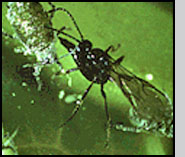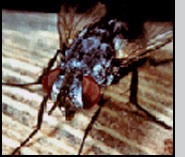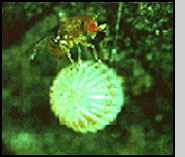 |
Parasitoids Table of Contents

Parasitoids
Insect parasitoids have an immature life stage that develops on or within a single insect host, ultimately killing the host, hence the value of parasitoids as natural enemies. Adult parasitoids are free-living and may be predaceous. Parasitoids are often called parasites, but the term parasitoid is more technically correct. Most beneficial insect parasitoids are wasps or flies, although some rove beetles (see Predators) and other insects may have life stages that are parasitoids.
Most insect parasitoids only attack a particular life stage of one or several related species. The immature parasitoid develops on or within a pest, feeding on body fluids and organs, eventually leaving the host to pupate or emerging as an adult. The life cycle of the pest and parasitoid can coincide, or that of the pest may be altered by the parasitoid to accommodate its development.
The life cycle and reproductive habits of beneficial parasitoids can be complex. In some species, only one parasitoid will develop in or on each pest while, in others, hundreds of young larvae may develop within the pest host. Overwintering habits may also vary. Female parasitoids may also kill many pests by direct feeding on the pest eggs and immatures.
Major characteristics of insect parasitoids:
- they are specialized in their choice of host
- they are smaller than host
- only the female searches for host
- different parasitoid species can attack different life stages of host
- eggs or larvae are usually laid in, on, or near host
- immatures remain on or in host; adults are free-living, mobile, and may be predaceous
- immatures almost always kill host

Relative Effectiveness
Whereas insect predators immediately kill or disable their prey, pests attacked by parasitoids die more slowly. Some hosts are paralyzed, while others may continue to feed or even lay eggs before succumbing to the attack. Parasitoids, however, often complete their life cycle much more quickly and increase their numbers much faster than many predators. Parasitoids can be the dominant and most effective natural enemies of some pest insects, but their presence may not be obvious. It is often necessary, to determine the extent of parasitism, to dissect or rear samples of pest insects to see if any adult parasitoids emerge.
Parasitoids can be parasitized by other parasitoids. This phenomenon, known as hyperparasitism, is a natural occurrence, can be common, and may reduce the effectiveness of some beneficial species. Little can be done to manage hyperparasitism.

Pesticide Susceptibility
Parasitoids are often more susceptible to chemical insecticides than predators. Adult parasitoids are usually more susceptible than their hosts. Immature parasitoids, especially if protected within the egg of their host or in their own cocoon, may tolerate pesticides better than adults, but immature parasitoids will usually die if their host is killed.

Taken from:
Hoffmann, M.P. and Frodsham, A.C. (1993) Natural Enemies of Vegetable Insect Pests. Cooperative Extension, Cornell University, Ithaca, NY. 63 pp.

|



|